Announcing: Catalog #302 (for January, 2021) is now available…
January 4, 2021 by GuyHeilenman · Leave a Comment
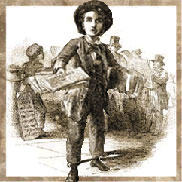
- Catalog 302 (in its entirety)
- Noteworthy Catalog 302 ($250+)
- Combined Catalogs (current, w/ remnants of previous)
Don’t forget about this month’s DISCOUNTED ISSUES.
The links above will redirect to the latest catalog in approx. 30 days,
upon which time it will update to the most recent catalog.
The February (2020) Newsletter from Rare & Early Newspapers…
February 17, 2020 by GuyHeilenman · Leave a Comment
Each month the staff of Timothy Hughes Rare & Early Newspapers sends out a newsletter to our members which includes special offers, discounts, alerts to new inventory, and information related to the rare newspaper collectible.
The February, 2020 newsletter:
|
|
I’m New Here: Week Forty-Two, Wishing You A Blessed Christmas!
December 21, 2019 by Stephanie Williams · Leave a Comment
 As this is the first gift ordering season I have experienced in the Rare Newspaper world, there is much I have learned recently. However, I am on a personal quest to keep the bustle of the season from obscuring the spiritual value of these days. It is the third week of Advent on the Christian calendar and my morning reflections are on Joy. I appreciate the preceding meditations have been on Hope and Peace, because without them Joy might feel a bit contrived, at least to me.
As this is the first gift ordering season I have experienced in the Rare Newspaper world, there is much I have learned recently. However, I am on a personal quest to keep the bustle of the season from obscuring the spiritual value of these days. It is the third week of Advent on the Christian calendar and my morning reflections are on Joy. I appreciate the preceding meditations have been on Hope and Peace, because without them Joy might feel a bit contrived, at least to me.
My good intentions, however, usually don’t survive the details of life. Into all the elevated mindset about to be swept away by the Monday morning deluge of business activity, came an anchoring phone call. The gentleman was seeking information about an issue out of Honolulu, dated December 7th. It is one of the most available reprints as there were three versions in addition to the original. This fellow was mostly interested in telling the story of his newlywed mother who followed her spouse out to Hawaii in 1941, where he was stationed on a naval destroyer in Pearl Harbor. He told how his mom took a job in the shipyard so she could stay, and her birthday was unexpectedly marked by sirens and smoke. This woman, who wouldn’t open gifts until her husband returned days later, was blessed to spend more than seventy more years with him.
It’s a beautiful story, and it encompasses much of the mindset of WWII. The newspaper headlines surrounding those days are larger-than-life to me, standing decades later. But the people who responded with extraordinary courage and forbearance and loyalty and perseverance were ordinary men and women who put their concerns aside for something greater than immediate comfort or convenience or even personal safety. And the reports, columns, psa’s and advertisements of the time only serve to bring that point home.
Anyway, Hope comes before Peace which comes before Joy.
And then comes Love.
The following poem by Christina Rossetti, eventually titled “Christmastide” was published in 1885:
Love came down at Christmas,
Love all lovely, Love Divine,
Love was born at Christmas,
Star and Angels gave the sign.
Worship we the Godhead,
Love Incarnate, Love Divine,
Worship we our Jesus,
But wherewith for sacred sign?
Love shall be our token,
Love be yours and love be mine,
Love to God and all men,
Love for plea and gift and sign.
Merry Christmas and Happy Holidays to all.
Announcing: Catalog #284 (for July, 2019) is now available…
July 2, 2019 by GuyHeilenman · Leave a Comment

- Catalog 284 (in its entirety)
- Noteworthy Catalog 284 ($250+)
- Combined Catalogs (current, w/ remnants of previous)
Don’t forget about this month’s DISCOUNTED ISSUES.
(The links above will redirect to the latest catalog in approx. 30 days, upon which time it will update to the most recent catalog.)
Announcing: Catalog #276 (for November, 2018) is now available…
November 1, 2018 by GuyHeilenman · Leave a Comment

- Catalog 276 (in its entirety)
- Noteworthy Catalog 276 ($250+)
- Combined Catalogs (current, w/ remnants of previous)
Don’t forget about this month’s DISCOUNTED ISSUES.
(The catalog links above will redirect to the latest catalog in approx. 30 days, upon which time it will update to the most recent catalog.)
*Error headlines make interesting collectibles…
March 14, 2017 by TimHughes · 2 Comments
Headlines of events that never happened offer a fascinating focus in the world of newspaper collecting. Unlike radio or television broadcasts where errors can be corrected in minutes, and without any “physical evidence” of the mistake, once ink is on the paper it cannot be retracted.
Certainly the most notable and desirable would be the famous Chicago Tribune mistake of November 3, 1948 which proclaimed in its early edition: “DEWEY DEFEATS TRUMAN” with issues in nice condition now extending well beyond the $1000 mark. Even in a later edition they continued the error but softening the headline by proclaiming: “G.O.P. WINS WHITE HOUSE!“, which I believe to be more rare than the more famous earlier edition.
One error newspaper which recently surfaced from our inventory comes with an interesting story, growing from the hysteria created by the surprise attack upon Pearl Harbor by Japan, which helped to usher in the U.S. involvement in World War II.
The Los Angeles Examiner “War Extra” of Feb. 25, 1942 proclaimed in large letters across its front page: “AIR BATTLE RAGES OVER LOS ANGELES“. Puzzled by the headline, as I wasn’t aware of any WWII battles reaching the shores of the United States, I did a bit of investigating.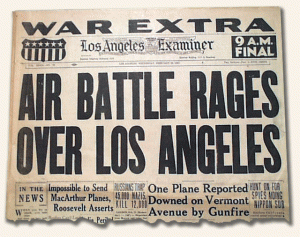
The short answer is there was no air battle over Los Angeles. Just some hysteria run amuck. During the night of February 24/25, 1942, unidentified objects caused a succession of alerts in southern California. On the 24th, a warning issued by naval intelligence indicated that an attack could be expected within the next ten hours. Probably much of the confusion came from the fact that anti-aircraft shell bursts, caught by the searchlights, were themselves mistaken for enemy planes. In any case, the next three hours produced some of the most imaginative reporting of the war: “swarms” of planes (or, sometimes, balloons) of all possible sizes, numbering from one to several hundred, traveling at altitudes which ranged from a few thousand feet to more than 20,000 and flying at speeds which were said to have varied from “very slow” to over 200 miles per hour, were observed to parade across the skies. These mysterious forces dropped no bombs and, despite the fact that 1,440 rounds of anti-aircraft ammunition were directed against them, suffered no losses. There were reports that four enemy planes had been shot down, and one was supposed to have landed in flames at a Hollywood intersection. Residents in a forty mile arc along the coast watched from hills or rooftops as the play of guns and searchlights provided the first real drama of the war for citizens of the mainland. The dawn, which ended the shooting and the fantasy, also proved that the only damage which resulted to the city was such as had been caused by the excitement (there was at least one death from heart failure), by traffic accidents in the blacked-out streets, or by shell fragments from the artillery barrage. Go here to read the full text of this fascinating “battle” as provided by the “Virtual Museum of the City of San Francisco”.
Do you have any interesting error headlines in your collection? Feel free to share with others.
*Note: This post was originally posted on 11/11/2008.
America – pulling a nation back together…
November 14, 2016 by GuyHeilenman · Leave a Comment
 My Fellow Americans: Devastating hurricanes, Pearl Harbor, 9-11, the end of WWII, Lindbergh’s 1st flight across the Atlantic – while there is much that divides us, there have been times throughout our history when both triumphs and tragedies have inspired us to lay down our weapons and to unite as one. While these times of mutual good will are typically short-lived, they often act as a reset to help center us on that which binds us together. We need such a time!
My Fellow Americans: Devastating hurricanes, Pearl Harbor, 9-11, the end of WWII, Lindbergh’s 1st flight across the Atlantic – while there is much that divides us, there have been times throughout our history when both triumphs and tragedies have inspired us to lay down our weapons and to unite as one. While these times of mutual good will are typically short-lived, they often act as a reset to help center us on that which binds us together. We need such a time!
It is was with the current atmosphere of angst as a backdrop that I was moved by an under-the-radar prayer found buried on page 11 of an issue reporting the assassination of President JFK. His death, airmailed via television directly into the living room of nearly every home in America, brought together Republicans, Democrats, and Independents alike and unified us around shared grief. May a day come when such unity of spirit flourishes without the inspiration of deep sorrow, tragedy, or war. As another assassinated President once said: “A house divided against itself cannot stand (Abraham Lincoln).” It is time for us to lay down our weapons. Much is at stake.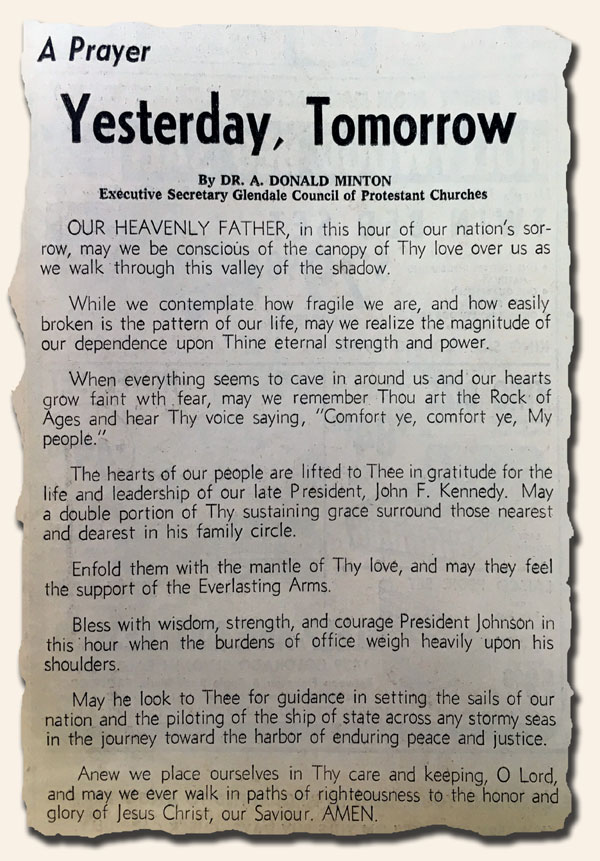
Seeking the best of the 20th century…
May 23, 2014 by TimHughes · Leave a Comment
 The introduction to collecting old newspapers for most typically comes through finding a newspaper of recent past with a headline remembered from history class. They turn up in flea markets, garage sales, and attics, but wherever the discovery, there is a fascination which—for many—begins a quest to find more and better.
The introduction to collecting old newspapers for most typically comes through finding a newspaper of recent past with a headline remembered from history class. They turn up in flea markets, garage sales, and attics, but wherever the discovery, there is a fascination which—for many—begins a quest to find more and better.
Of the five centuries from which old newspapers can be found, the 20th century has one distinct advantage and that is displayability. It was just before the turn of the 20th century that newspaper competition was rampant in the United States and bigger and bigger headlines became one method of grabbing attention over a competitor’s newspaper on the corner newsstand. Headlines from the Spanish-American War of 1898 were often large and dramatic, and that format carried well into the 20th century. Although the aim was to sell more newspapers, the unintended long-term consequence was to intrigue the collector with an enticing headline that would look great on display.
I will touch on some of the more notable events of the 20th century, in chronological order, which may present a “checklist” of events which would be great additions to any collection.
Their can be little question that the oil industry transformed the American landscape, and the first major discovery happened at the beginning 20th century with the Spindletop well near 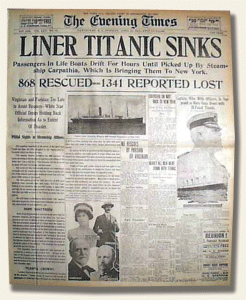 Houston. Just two years later the Wright brothers would make history with their first powered flight, again an event which would transform that way the entire world lives. The first major natural tragedy would be the San Francisco earthquake of 1906, and many newspapers provided graphic details.
Houston. Just two years later the Wright brothers would make history with their first powered flight, again an event which would transform that way the entire world lives. The first major natural tragedy would be the San Francisco earthquake of 1906, and many newspapers provided graphic details.
The sinking of the Titanic was the next major tragedy which dominated the headlines for not just a day but for several weeks, and newspapers did much to dramatize the event & its investigation. While some newspaper maintained a very conservative format, others sported full banner headlines in bold type with illustrations and photos to make for an appealing front page. Just 3 years later the sinking of the Lusitania would receive similar response by newspaper publishers across the country.
World War I made headlines in American newspapers beginning in 1915, but it was America’s entry in the war in 1917 that would spark more detailed coverage of the war that would end in 1918. News of the armistice ending the war would result in some of the largest & most dramatic headlines to appear in newspapers up to that time.
Following the war, baseball would enter its golden era when Babe Ruth came on the scene, he becoming one of the first of the major stars of the 20th century and capturing headlines in newspapers across the country. But just prior to his hay-day was the infamous “Black Sox” 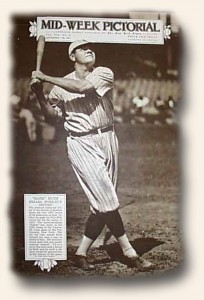 scandal of the Chicago White Sox, with charges of fixing the 1919 World Series games involving several Chicago players. But those headlines would soon be supplanted by the exploits of Ruth as his record-breaking streak added much excitement to the game of baseball and newspapers were only too happy to comply with considerable coverage. Other stars would find prominence as well, including fellow Yankees Lou Gehrig & Joe DiMaggio, and later on Ted Williams & Jackie Robinson among the more notable.
scandal of the Chicago White Sox, with charges of fixing the 1919 World Series games involving several Chicago players. But those headlines would soon be supplanted by the exploits of Ruth as his record-breaking streak added much excitement to the game of baseball and newspapers were only too happy to comply with considerable coverage. Other stars would find prominence as well, including fellow Yankees Lou Gehrig & Joe DiMaggio, and later on Ted Williams & Jackie Robinson among the more notable.
Charles Lindbergh’s accomplishment of being the first to fly solo across the Atlantic caused him to be one of the most famous men in the world at the time, and newspaper coverage was exceptional. But shortly after his 1927 flight the gangster era came to the attention of newspaper, the St. Valentine’s Day massacre of 1929 being one of the first major events to find front page coverage across the country. This fascinating era would extend into the mid-1930’s and names such as Al Capone, John Dillinger, “Baby Face” Nelson, “Legs” Diamond and “Dutch” Schultz were commonly found on front pages.
The stock market crash of 1929 would trigger the Great Depression, which affect the entire nation in so many ways. Collectors look for the most dramatic wording in such a headline, with “Crash” “Tragedy” and similar cataclysmic words making for desirable collector pieces.
Other sports and sports stars would come to prominence in newspapers of the day, including golfer Bobby Jones and his Triple Crown accomplishment in 1930; Phar Lap, one of the 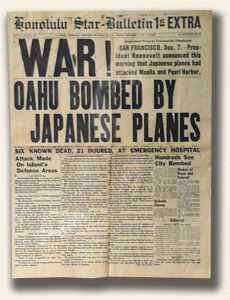 more famous race horses of the 20th century; Jim Thorpe and his Olympic and football prowess; Jesse Owens at the 1936 Olympics, World Cup soccer, Notre Dame football, boxing greats Jack Johnson, Jack Sharkey, Max Schmeling & Joe Louis commanding headlines, and so much more. There was such extensive coverage of sports in the 20th century that many build huge collections with this singular theme.
more famous race horses of the 20th century; Jim Thorpe and his Olympic and football prowess; Jesse Owens at the 1936 Olympics, World Cup soccer, Notre Dame football, boxing greats Jack Johnson, Jack Sharkey, Max Schmeling & Joe Louis commanding headlines, and so much more. There was such extensive coverage of sports in the 20th century that many build huge collections with this singular theme.
Perhaps the most defining event of the 20th century was World War II, begun with the ascendency of Adolf Hitler and the Nazi party in Germany and his invasion of Poland in 1939. With America’s entry in the war upon the attack on Pearl Harbor, barely a single newspaper for the next 4 ½ years would be devoid of war coverage. Because such issues were commonly saved and found in attics by their children, collectors pursue only the most major events and with the largest headlines. Tops of the list would be Pearl Harbor, battle of Midway, the D-Day invasion, the death of Hitler, the end of the war in Europe, the dropping of the atomic bomb, and the end of the war in the Pacific. Many tabloid-size newspapers had the entire front page consumed by headlines, lending themselves to displayability, particularly given their smaller size.
The Korean War would begin the 1950’s, and would be followed by events of the Cold War. At the end of the decade music would begin making some headlines, led by Elvis Presley and more tragically with the airplane death of Buddy Holly & Richie Valens. A few years later the Beatles would come on the scene to define the music world for the 1960’s.
 Politics always made headlines in the 20th century which began with McKinley and ended with Bill Clinton, but perhaps the most collectible political person would be John F. Kennedy. His assassination –the second of the 20th century–stunned the world , and some headlines were extremely dramatic. Always the “best of the best” would be newspapers from where the event happened, so it is no surprise that Dallas newspaper reports on the JFK assassination draw the most interest.
Politics always made headlines in the 20th century which began with McKinley and ended with Bill Clinton, but perhaps the most collectible political person would be John F. Kennedy. His assassination –the second of the 20th century–stunned the world , and some headlines were extremely dramatic. Always the “best of the best” would be newspapers from where the event happened, so it is no surprise that Dallas newspaper reports on the JFK assassination draw the most interest.
Although the space era began as early as 1928 with the work of Robert Goddard, it was the success of Sputnik & the resulting space race in the late 1950’s that would captivate the headlines. America made its mark in the early 1960’s with Alan Shepard and John Glenn, culminating in 1969 with the landing of men on the moon & their safe return.
Scattered throughout the 20th century are many memorable names which made the occasional headline, including Mark Twain, Thomas Edison, Houdini, Albert Einstein, Rudolph Valentino & Walt Disney to name but a few.
Regardless what events or themes a collector might pursue from the 20th century the challenge is to find the most dramatic and impactful report. Large headlines command a premium, and when photos or graphics accompany a headline it only adds to the appeal. Collectors know some great headline reports are lurking out there just begging to be found. The thrill is finding them, and make them prized additions to their collection.
The Battle of Los Angeles…
March 14, 2014 by TimHughes · 2 Comments
 The “Los Angeles Times–Extra” of February 24, 1942 has one of the more dramatic, screaming headlines to be found in any newspaper: “L.A. AREA RAIDED ! ” with a smaller head noting: “Jap Planes Peril Santa Monica, Seal Beach, El Segundo, Redondo, Long Beach, Hermosa, Signal Hill”. The report begins: “Roaring out of a brilliant moonlit western sky, foreign aircraft flying both in large formation and single, few over Southern California early today and drew heavy barrages of anti-aircraft fire–the first ever to sound over United States continental soil against an enemy invader…” (see).
The “Los Angeles Times–Extra” of February 24, 1942 has one of the more dramatic, screaming headlines to be found in any newspaper: “L.A. AREA RAIDED ! ” with a smaller head noting: “Jap Planes Peril Santa Monica, Seal Beach, El Segundo, Redondo, Long Beach, Hermosa, Signal Hill”. The report begins: “Roaring out of a brilliant moonlit western sky, foreign aircraft flying both in large formation and single, few over Southern California early today and drew heavy barrages of anti-aircraft fire–the first ever to sound over United States continental soil against an enemy invader…” (see).
The Battle of Los Angeles, also known as The Great Los Angeles Air Raid, is the name given to this rumored enemy attack and subsequent anti-aircraft artillery barrage which took place from late February 24 to early February 25, 1942 over Los Angeles. The incident occurred less than three months after the United States entered World War II as a result of the Japanese Imperial Navy’s attack on Pearl Harbor.
Initially, the target of the aerial barrage was thought to be an attacking force from Japan, but speaking at a press conference shortly afterward, Secretary of the Navy Frank Knox called the incident a “false alarm.” Newspapers of the time published a number of reports and speculations of a cover-up. Some modern-day UFOlogists have suggested the targets were extraterrestrial spacecraft. When documenting the incident in 1983, the U.S. Office of Air Force History attributed the event to a case of “war nerves” likely triggered by a lost weather balloon and exacerbated by stray flares and shell bursts from adjoining batteries.
Air raid sirens sounded throughout Los Angeles County on the night of February 24-25, 1942. A total blackout was ordered and thousands of air raid wardens were summoned to their positions. At 3:16 am the 37th Coast Artillery Brigade began firing .50 caliber machine guns and 12.8-pound anti-aircraft shells into the air at reported aircraft; over 1,400 shells would eventually be fired. Pilots of the 4th Interceptor Command were alerted but their aircraft remained grounded. The artillery fire continued sporadically until 4:14 am. The “all clear” was sounded and the blackout order lifted at 7:21 am.
Several buildings and vehicles damaged by shell fragments, and five civilians died as an indirect result of the anti-aircraft fire, three of them killed in car accidents in the ensuing chaos and two of heart attacks attributed to the stress of the hour-long action. The incident was front-page news along the U.S. Pacific coast, and earned some mass media coverage throughout the nation.(credit to Wikipedia)
Headlines drive interest in World War II…
March 11, 2013 by TimHughes · 2 Comments
For likely a multitude of reasons, interest in World War II newspapers ranks far higher than in the Korean War, World War I, or the Spanish-American War. It may be a generational thing, as most collectors today are children of World War II veterans and likely heard stories of the war first-hand, or found 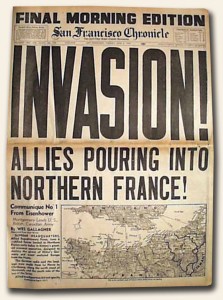 newspapers in their parents attics which sparked an interest. One could debate a number of other possible reasons why other wars lack the intrigue found in that fought by the “greatest generation”.
newspapers in their parents attics which sparked an interest. One could debate a number of other possible reasons why other wars lack the intrigue found in that fought by the “greatest generation”.
Headline collecting has always been a focus for this hobby, and as any collector knows, bold, banner headlines did not become commonplace until late in the 19th century. With the increasing competitiveness of daily newspapers across the country–Hearst, Pulitzer & others rising to prominence–flashier front pages were needed to draw attention at the corner news stand. It’s a shame there is not more interest in the Spanish-American War and World War I as both events resulted in some huge, dramatic, & very displayable headlines.
Because there are a plethora of newspapers from the WWII era available, collectors have become very discriminating in what they collect. Only the “best of the best” will do, meaning just the major events and only those with huge and displayable headlines. If there is a “top 6” list of sought-after events, our experience is they would be: 1) attack on Pearl Harbor; 2) the D-Day invasion; 3) death of Hitler; 4) end of the war in Europe; 5) dropping of the atomic bomb; 6) end of the war in the Pacific. One could add any number of other battle reports such as Midway, battle of the Bulge, fall of Italy, Iwo Jima, battle for Berlin, and so much more. And we could step back before American involvement in the war and add Hitler’s invasion of Poland and the battle of Britain.
The bigger the headline the better. With some newspapers the entire front page was taken up with a headline and a related graphic. The U.S. flag was a common patriotic device. Tabloid-size newspapers commonly had the front page entirely taken up with a singular headline and tend to be better for display given their smaller size.
 And not just American newspapers draw interest. German newspapers hold a special intrigue, but the language barrier is a problem for many. But the British Channel Islands, located in the English Channel between England & France, were occupied by the Nazi during the war so their reports were very pro-Nazi while printed in the English language (ex., Guernsey Island). And the military newspaper “Stars and Stripes“, while certainly being American, was published at various locations in Europe and the Pacific. Collectors have a special interest in finding World War II events in the official newspapers of the American military forces. Plus there were a multitude of “camp” newspapers, amateur-looking newspapers printed on a mimeograph machine for consumption limited to a military base, and typically printed is very small quantities. Their rarity is not truly appreciated by many.
And not just American newspapers draw interest. German newspapers hold a special intrigue, but the language barrier is a problem for many. But the British Channel Islands, located in the English Channel between England & France, were occupied by the Nazi during the war so their reports were very pro-Nazi while printed in the English language (ex., Guernsey Island). And the military newspaper “Stars and Stripes“, while certainly being American, was published at various locations in Europe and the Pacific. Collectors have a special interest in finding World War II events in the official newspapers of the American military forces. Plus there were a multitude of “camp” newspapers, amateur-looking newspapers printed on a mimeograph machine for consumption limited to a military base, and typically printed is very small quantities. Their rarity is not truly appreciated by many.
For obvious reasons, there is also a high degree of collectible interest from those wishing to make sure certain aspects of history are not forgotten. The Holocaust, and the Nazi propaganda used to provide a rationale for eliminating the Jewish people, is well documented in newspapers from the era. In addition to the Holocaust and its atrocities, issues providing context through reporting other pre-war events such as the Great Depression, fascism, and increased militarism, are also desirable.
True to any collectable field, newspaper collectors are always on the lookout for an issue better than what they have, and collection upgrades are constant. Finding that special, rare, unusual or fascinating headline is what makes the hobby fun. Will interest in the Korean War and the Vietnam War gain more interest in future years? Perhaps so. With interest currently low and availability and prices very attractive, it might be a good time to explore.


